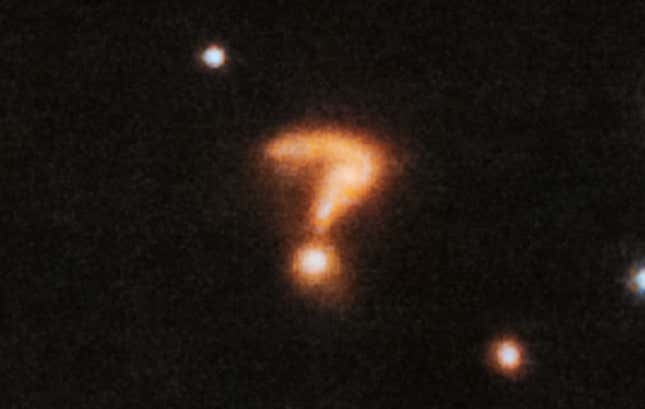The James Webb Space Telescope captured the eerie punctuation mark, found buried within an image of Herbig-Haro 46/47—a tightly bound pair of actively forming stars located 1,470 light years from Earth.
The high-resolution near-infrared image, captured by the Webb Space Telescope, a project from NASA in collaboration with the European Space Agency and the Canadian Space Agency, came out last week. But if you zoom in close enough (at the center bottom), you’ll see an astronomical feature that, from our perspective, bears an uncanny resemblance to a question mark, as Space.com points out.
Advertisement

The unexpected question mark suggests a cosmological message from aliens, God, or the posthuman civilization running our simulated universe, but its underlying cause is far less extraordinary.
Advertisement
Advertisement
In response to a Space.com query, representatives of the Space Telescope Science Institute (STScI), which manages Webb’s science operations, speculate that this cosmic question mark could be a distant galaxy or a pair of interacting galaxies. In those scenarios, gravitational forces could have manipulated these galactic structures, leading to the distorted, question mark-like shape. Interestingly, this might be the first time that astronomers have set their eyes on this distant object (or objects), which exists far outside the bounds of our Milky Way galaxy.

Matt Caplan, an assistant professor of physics at Illinois State University, reaffirmed this suspicion, telling Space.com that the unique feature is likely two galaxies in the process of merging. In his interpretation, the distinct shape of the upper object is a potential sign of the “larger galaxy getting tidally disrupted,” he told Space.com. In other words, the bigger galaxy is being pulled apart, or distorted, due to gravitational forces.
That we’re bound to see familiar shapes in mundane objects should be expected, especially when peering into the vastness of space. There’s the ghost-like Boomerang nebula, the spooky face of Arp-Madore 2026-424 s (two merging galaxies), and the jack-o-lantern Sun, as some other examples.
Advertisement
More: The weirdest images ever taken on Mars
Services Marketplace – Listings, Bookings & Reviews